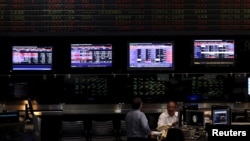Argentina said on Wednesday it was lifting its currency controls in a bid to normalize and boost Latin America's third-largest economy, adding it expected the peso to weaken to around 30.8 percent to the U.S. dollar.
President Mauricio Macri, a free markets advocate who took office last week, has promised to loosen state controls on the economy and allow the peso to weaken in a bid to raise exports and spark growth.
His finance minister, Alfonso Prat-Gay, held a news conference to announce the end of capital restrictions known as the "cepo" and introduced under former President Cristina Fernandez in 2011 to protect the country's low foreign reserves.
"We are very happy to be able to announce today the end of the monetary 'cepo' in Argentina," Prat-Gay said. "He who wants to import will be able to do so, and he who wants to buy dollars will be able to buy them."
Asked what he expected the exchange rate to be now they were floating the currency, Prat-Gay said there was "no magic number." However, the most realistic exchange rate at the moment was the "blue-chip swap" rate, used to buy Argentine assets traded abroad, he said.
That rate is currently around 14.2 pesos per dollar, compared with the official exchange rate of 9.8275.
Prat-Gay said he expected the central bank to agree to a credit line with Wall Street investment banks worth more than $5 billion which would be ready in the next 10 days, bolstering low foreign reserves.
Moreover, Argentina has agreed with China to convert a large quantity of yuan from its currency swap line into dollars in the next few hours, he said.
Farmers in the grains-exporting powerhouse have been waiting for the currency to weaken before selling stockpiles of soybeans that had piled up under Fernandez.
Argentina has sealed a deal with grains producers to liquidate $400 million of produce per day over the next few weeks, Prat-Gay said. This should ensure more dollar supply in the economy.










